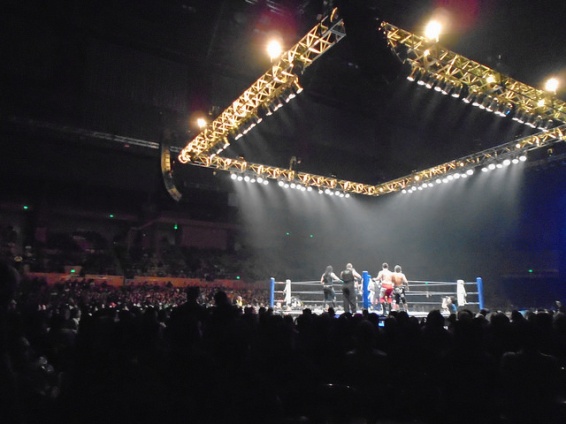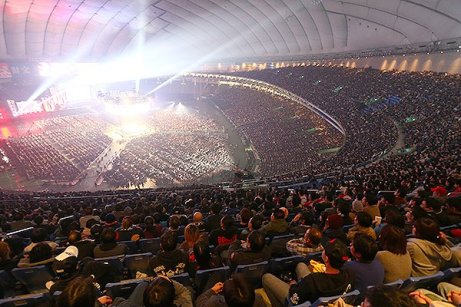
Image Source (x)
For this project, I plan to delve into the world of professional wrestling in Japan.
When I was younger, I was very much a fan of the WWE, the most prominent and notable wrestling promotion, possibly in the world. It currently airs in more than 150 different countries, broadcasting to over 36 million viewers. While I still, to this day, tune in sporadically, especially if my younger brother happens to be watching it while I have nothing on, I’ve only ever experienced professional wrestling through the WWE, and as such, this project will be an entirely new experience, as previous to this blog post, I had very little knowledge of this field site.
While professional wrestling in Japan hasn’t been around nearly as long as it has in Europe and the United States, it has continued to rapidly gain popularity, and the leading promotions have been chipping away at the lead to which the WWE has enjoyed for an extended amount of time. Japanese professional wrestling, or ‘puroresu’, is said to have begun in 1950s, when the Japan Pro Wrestling Alliance organisation was established in 1953, and the sport of professional wrestling caught the eye of the Japanese audience very quickly. One only has to look towards a survey, undertaken in 1954, which looked into viewers preference of programs being broadcast as evidence of this. The survey results found that the “most popular type of program was feature films (74.1 %), with the next most popular being professional wrestling (71.4%) (Thompson, 1986)”. In a similar survey conducted in March 1961, “professional wrestling came in first, this time with a rating of 60.5% (Thompson, 1986)”.
Looking at the professional wrestling landscape in Japan today, there have been numerous professional wrestling organisations that have since been established, and many have begun to make a name for themselves, even on a global scale. However, I am choosing for this project to focus on numerous matches within the professional wrestling organisation known as ‘New Japan Pro Wrestling‘, which is already the largest pro wrestling organisation in Japan and is currently the fasting growing promotion in the world.

Image source (x)
This promotion peaked in popularity during the 1990s, after founded in January of 1972. In 1996, the show’s revenue peak at around $36m, and projected figured from last year revealed that the revenue would come close to the same number. What differs this promotion from not only others in Japan, but more importantly, the WWE, is that NJPW is incredibly wrestling-centric. Known for hard-striking, stiff-kicking, mixed-discipline fighting that’s become increasingly globally influential as mixed martial arts has ascended in popularity, the wrestling is at the forefront, and the unique style of wrestling, and atmosphere that is created, means that their various shows feel different from any other sort of promotion in the States. While Japan remained the companies main audience, Takaaki Kidani, the companies current owner has previously outlined his plans to overtake WWE as the sport’s main organisation. From what I have read so far, there are definitely strong communities online that believe that NJPW is by far the greater professional wrestling organisation. I plan to continue to research the popularity of professional wrestling in Japan, with a focus on the spike in attention it has received in recent years, and the reasoning behind this.
For this project, the current plan is to watch and react to up to 3-5 matches from the NJPW company. I am hoping that each match I chose and react to reflect a different style, or tell a different story, in order to gain the most experience in this field site, and gain a significant insight into professional wresting in Japan. To collect the data from these reactions, the plan is to live-tweet throughout the matches, as I feel this is the most efficient way to collect the data, as it will allow me to effectively “describe and systematically analyze personal experience in order to understand cultural experience (Ellis et al 2011)”.
This is a process that I have already begun. Being a complete beginner in this field site, I really had no idea where to start, so I simply performed a quick Google search to find the best match to watch as someone who had never experienced anything in NJPW. While many different options came up, I took to the suggestion to watch a match between Katsuyori Shibata and Tomohiro Ishii, from the G1 Climax 23 in 2013. What drew me to this match was the fact that it was described to showcase a completely different, and unique style than that seen in the WWE (to which I’m used to), and it didn’t disappoint. My first tweet about the match showcased that.

It was a a brutal and insanely hard-hitting contest, and the crowd were absolutely losing their minds over it. This match only clocked in at around 12 minutes, but it was a great first experience into Japanese professional wrestling. I’ll include the rest of my tweets below.
References
Ellis, C., Adams, T.E., and Bochner, A.P. (2011) ‘Autoethnography: An Overview‘, Forum: Qualitative Social Research, 12:1. Available at: http://www.qualitative-research.net/index.php/fqs/article/view/1589/3095
Thompson, L. (1986). Professional Wrestling in Japan — Media and Message. International Review for the Sociology of Sport, 21(1), pp.65-81.
Reblogged this on Digital Asia.
LikeLike
Pingback: Professional Wrestling in Japan – Researchers Cultural Framework | The Fish Pond
Hi Brendon, I saw the title of your blog post and was so intrigued of it. I grew up on wrestling as well, I had 3 brothers so the WWE was definitely popular in our house. I only really knew of New Japan from WWE wrestlers who came from there. I can imagine it is quite different, the fighting style and the audiences. The US is quite drama and storyline based and has characters that are very marketable. Your research process of live-tweeting is a good way of recording your reactions which you can then go back and reflect on your cultural experience. It reflects the Ellis reading well as you stated. The first match you watched you said they were fighting hardcore straight away, I actually looked up if NJPW has a ‘rated’ system but couldn’t find anything. Thought that was interesting because WWE is now PG and more child friendly so it’s not as extreme but the ‘attitude era’ and ECW back in the day definitely was. Looking forward to seeing what you think of the rest of the matches!
LikeLike
Pingback: Professional Wrestling In Japan – Final Autoethnography Project | The Fish Pond